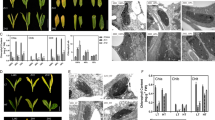Abstract
A multiple gene family of at least four members, related to a GA-stimulated transcript (GAST1) from tomato, was characterized in Arabidopsis thaliana by analysing four related cDNAs, named GASA1 to GASA4. The corresponding peptides display comparable structural features: (1) a putative signal peptide of 18 to 23 residues; (2) a highly divergent hydrophilic region of about 22 amino acids; (3) a conservative 60 amino acid C-terminal domain containing 12 cysteines. This organization has also bean shown in two related peptides from tomato, GAST1 found in shoots and RSI-1 found in early lateral roots. Southern blot hybridization patterns showed single-copy genes for all four members of the GASA family. Accumulation of the various transcripts, monitored by northern blot hybridization, indicated that the various genes are expressed differentially in plant organs. Specific mRNAs were mostly detected in flower buds and immature siliques in the case of GASA1, in siliques and dry seeds in the case of GASA2 and 3, and in growing roots and flower buds in the case of GASA4. At least two of the GASA genes are activated in GA-deficient mutant ga5, as early as 4 to 8 h after spraying with 50 μM GA3. The complex patterns of expression and regulation of the various genes suggest that the related peptides are involved in a developmental regulation process in Arabidopsis.
Similar content being viewed by others
References
Bernier G, Havelange A, Houssa C, Petitjean A, Lejeune P: Physiological signals that induce flowering. Plant Cell 5: 1147–1155 (1993).
Cejudo FJ, Ghose TK, Stabel P, Baulcombe DC: Analysis of the gibberellin-responsive promoter of the cathepsin B-like gene from wheat. Plant Mol Biol 20: 849–856 (1992).
Davies PJ: Plant Hormones and Their Role in Plant Growth and Development. Kluwer Academic Publishers, Dordrecht (1990).
Dellaporta SL, Wood J, Hicks JB: A plant DNA minipreparation: version II. Plant Mol Biol Rep 1: 19–21 (1983).
Gabard A, Jones RL: Localization of phytase and acid phosphatase in aleurone layers of barley. Physiol Plant 67: 182–192 (1986).
Gaboriaud C, Bissery V, Benchetrit T, Mornon JP. Hydrophobic cluster analysis: an efficient new way to compare and analyse amino acid sequences. FEBS Lett 224: 149–155 (1987).
Graebe JE: Gibberellin biosynthesis and control. Annu Rev Plant Physiol 38: 419–465 (1987).
Granell A, Harris N, Pissabaro AG, Carbonell J: Temporal and spatial expression of a thiolprotease gene during pea ovary senescence, and its regulation by gibberellins. Plant J 2: 907–915 (1992).
Höfte H et al.: An inventory of 152 expressed sequence tags obtained by partial sequencing of cDNAs from Arabidopsis thaliana. Plant J 4: 1051–1061 (1993).
Joshi CP: An inspection of the domain between putative TATA box and translation start site in 79 plant genes. Nucl Acids Res 15: 6643–6653 (1987).
Koornneef M, van derVeen JH: Induction and analysis of gibberellin sensitive mutants in Arabidopsis thaliana (L.) Heynh. Theor Appl Genet 58: 257–263 (1980).
Koornneef M: Gibberellin-sensitive mutants in Arabidopsis thaliana. Arabidopsis Inf Serv 15: 17–20 (1978).
Lanahan MB, Ho THD, Rogers SW, Rogers JC: A gibberellin response complex in cereal α-amylase gene promoters. Plant Cell 4: 203–211 (1992).
Lemesle-Varloot L, Henrissat B, Gaboriaud C, Bissery V, Morgat A, Mornon JP: Hydrophobic cluster analysis: procedures to derive structural and functional information from 2D-representation of protein sequences. Biochimie 72: 555–574 (1990).
Logemann J, Schell J, Willmitzer L: Improved method for the isolation of RNA from plant tissues. Anal Biochem 163: 16–22 (1987).
Marc J, Hackett P: Gibberellin-induced reorganization of spatial relationships of emerging leaf primordia at the shoot apical meristem in Hedera helix L. Planta 185: 171–178 (1991).
Mita T, Katsumi M: Gibberellin control of microtubule arrangement in the mesocotyl epidermal cells of the d5 mutant of Zea mays L. Plant Cell Physiol 27: 651–659 (1986).
Pharis RP, King RW: Gibberellins and reproductive development in seed plants. Annu Rev Plant Physiol 36: 517–568 (1985).
Phillips AL, Huttly AK: Cloning of two gibberellin-regulated cDNAs from Arabidopsis thaliana by substractive hybridization: expression of the tonoplast water channel, γ-TIP, is increased by GA3. Plant Mol Biol 24: 603–615 (1994).
Rogers JC, Rogers SW: Definition and functional implications of gibberellin and abscisic acid cis-acting hormone response complexes. Plant Cell 4: 1443–1451 (1992).
Sambrook J, Fritsch EF, Maniatis T: Molecular Cloning: A Laboratory Manual, 2nd ed. Cold Spring Harbor Laboratory Press, Cold Spring Harbor, NY (1989).
Shi L, Gast RT, Gopalraj M, Olszewski NE: Characterization of a shoot-specific, GA3 and ABA-regulated gene from tomato. Plant J 2: 153–159 (1992).
Skriver K, Olsen FL, Rogers JC, Mundy J: Cis-acting DNA elements responsive to gibberellin and its antagonist abscisic acid. Proc Natl Acad Sci USA 88: 7266–7270 (1991).
Takahashi N, Phinney BO, MacMillan J: Gibberellins. Springer-Verlag, Berlin/Heidelberg/New York (1990).
Talon M, Koornneef M, Zeevaart JAD: Endogenous gibberellins in Arabidopsis thaliana and possible steps blocked in the biosynthetic pathways of the semi-dwarf ga4 and ga5 mutants. Proc Natl Acad Sci USA 87: 7983–7987 (1990).
Taylor BH, Scheuring CF: A molecular marker for lateral root initiation: the RSI-1 gene of tomato (Lycopersicon esculentum Mill) is activated in early lateral root primordia. Mol Gen Genet 243: 148–157 (1994).
von Heijne. A new method for predicting signal sequence cleavage sites. Nucl Acids Res 14: 4683–4690 (1986).
Washio K, Ishikawa K: Structure and expression during the germination of rice seeds of the gene for a carboxypeptidase. Plant Mol Biol 19: 631–640 (1992).
Watanabe H, Abe K, Emori Y, Hosoyama H, Arai S: Molecular cloning and gibberellin-induced expression of multiple cysteine proteinases of rice seeds (orizains). J. Biol Chem 266: 16897–16902 (1991).
Weiss D, vanTunen AJ, Halevy AH, Mol JNM, Gerats AGM: Stamens and gibberellic acid in the regulation of flavonoid gene expression in the corolla of Petunia hybrida. Plant Physiol 94: 511–515 (1990).
Author information
Authors and Affiliations
Rights and permissions
About this article
Cite this article
Herzog, M., Dorne, AM. & Grellet, F. GASA, a gibberellin-regulated gene family from Arabidopsis thaliana related to the tomato GAST1 gene. Plant Mol Biol 27, 743–752 (1995). https://doi.org/10.1007/BF00020227
Received:
Accepted:
Issue Date:
DOI: https://doi.org/10.1007/BF00020227




